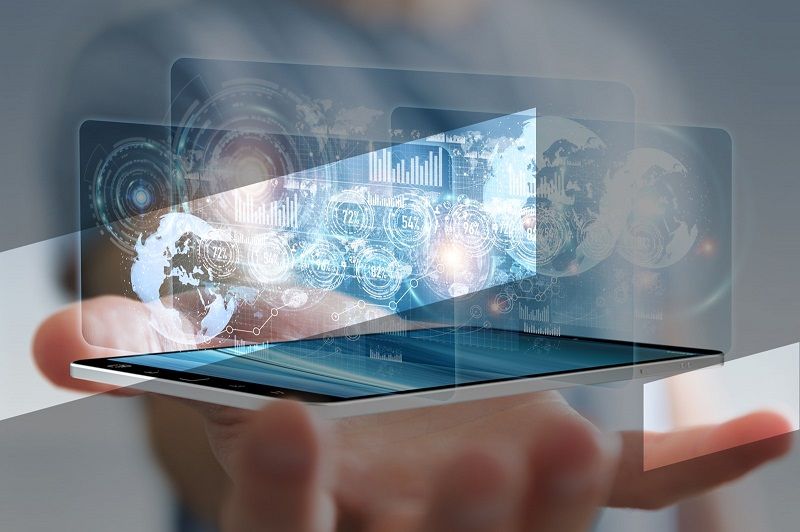Top Smartphone Technology – Cell phones will soon become even more intelligent. Mobile phones’ capabilities today are merely a tiny portion of what they were in the middle of the 2000s. Now, there won’t be a shortage of new smartphone features in the future to keep us evermore hooked to our little digital devices, thanks to several recent technological developments. Here are some things to be on the lookout for.
Top Smartphone Technology
Displays With Photonic Crystals
Even though most modern smartphone screens can display a broad spectrum of intensely saturated colors, most struggle to adjust to changing lighting situations. Photonic crystals are being considered as the solution to this constraint by research and development at the moment.
A photonic crystal display has nanostructures that adjust and modify themselves in response to the amount of ambient light in a specific environment rather than emitting bright light like LCD or OLED displays. While an external light source is necessary for the photonic screen to be seen, this could be built within the phone’s body, just like in e-readers like the Kindle Paper white.
6G Technology
3G, 4G, 5G. It just makes sense that we move to 6G. The next generation of wireless is known called as 6G.
It is believed that 6G will be a broadband cellular network, similar to its forerunners. It will ostensibly offer even faster and more reliable internet than 5G. Many large corporations, including Apple, and Samsung, demonstrate significant interest in this evolving technology.
Flow Buttons / Liquid Buttons
In the past, physical keyboards on phones were the norm, and any mobile device without one was considered “out of date.” Today, however, the contrary is accurate, and most people believe touch keyboards are outdated. That’s about to change once more thanks to Tactus Technology, which created a keyboard that resembles something from a sophisticated alien society.
Nano Batteries
Ever notice your phone is on 10% and you need to leave the house in 10 minutes? But what if we told you that shortly, your battery might charge entirely in minutes, perhaps even seconds? Always a frustrating situation.
The use of nano batteries would be the only factor in this quick charging. In essence, the term “nano” refers to relatively small. This term may be familiar, and smartphone technology is now being developed.
Authentication Via Biometric
Using capacitive technology, the Samsung Galaxy S6 and the iPhone 6 read the ridges on your fingertips. However, this technology could be considered inadequate from a security standpoint because it doesn’t use enough data points, making it more vulnerable to hacking. Qualcomm, a company that makes telecoms equipment, has improved the idea by creating a brand-new ultrasonic fingerprint scanner using a piezoelectric layer to produce ultrasound. The scanner not only maps your finger, but it also has a far higher resolution, which improves security.
Over-The-Air Charging
The battery life of the typical smartphone is terrible; let’s face it. Even if you have a high-end phone with a big 5,000mAh battery, like the Galaxy S22 Ultra, you’re still only looking at two days of everyday use. When the battery runs out, you must either plug it in or set it down on a wireless charging station if your phone supports it. Future events might be very different. The Motorola air-to-air charging system, which can charge devices up to one meter away from the charging transmitter, was unveiled last year. Learn more about the demonstration of Xiaomi’s Mi Air Charge, which has a few-meter radius.
No SIM Cards
Although manufacturers have made an effort to make SIM cards smaller, they still have a distinctly 1990s feel about them. Thankfully, Apple and Samsung are working to eliminate SIM cards from the physical world by introducing an electronic alternative.
You’ll effectively be able to move between network providers at the drop of a hat if your phone has a programmable SIM built-in without needing to get a new SIM card, which should be very helpful for anyone who wishes to set up with a local number when traveling or residing overseas. The technology is rumored to be included in new cellphones as early as next year.
No SIM Cards
Despite efforts by manufacturers to reduce the size of SIM cards, they nevertheless have a decidedly 1990s vibe. Thankfully, Apple and Samsung are striving to replace SIM cards with an electronic counterparts, making them obsolete in the physical world.
Suppose your phone has a programmable SIM built-in. In that case, you can effectively switch network providers without getting a new SIM card, which ought to be extremely useful for anyone who wants to set up a local number when traveling or living abroad. According to rumors, the technology will be present in future handsets as early as next year.
FAQ
What will smartphone technology look like in the future?
Picture the most cutting-edge smartphone technology of the future. Smartphones will continue to develop, despite the recent slowdown in development. Others say they may vanish into wearable technology like glasses or watches, becoming more like remote controls for our lives.
In 2030, how will phones look?
People will probably rely less on actual wires as wireless chargers become more common and, more crucially, faster at charging your smartphone, making a port increasingly unnecessary. It is similar to wireless headphones, and portless smartphones may become commonplace in 2030.
Final Words
There’s virtually no way of knowing what cellphones will look like in ten years, given how quickly technology is developing. You’ve probably seen internet images of translucent smartphones or even holographic smartphones.
But as time goes on, technology might advance beyond dreams. Smartphones are becoming more integral to our lives due to the development and integration of AI and the constant increase in the need for information sharing. They may eventually become more of a blessing than a curse.

